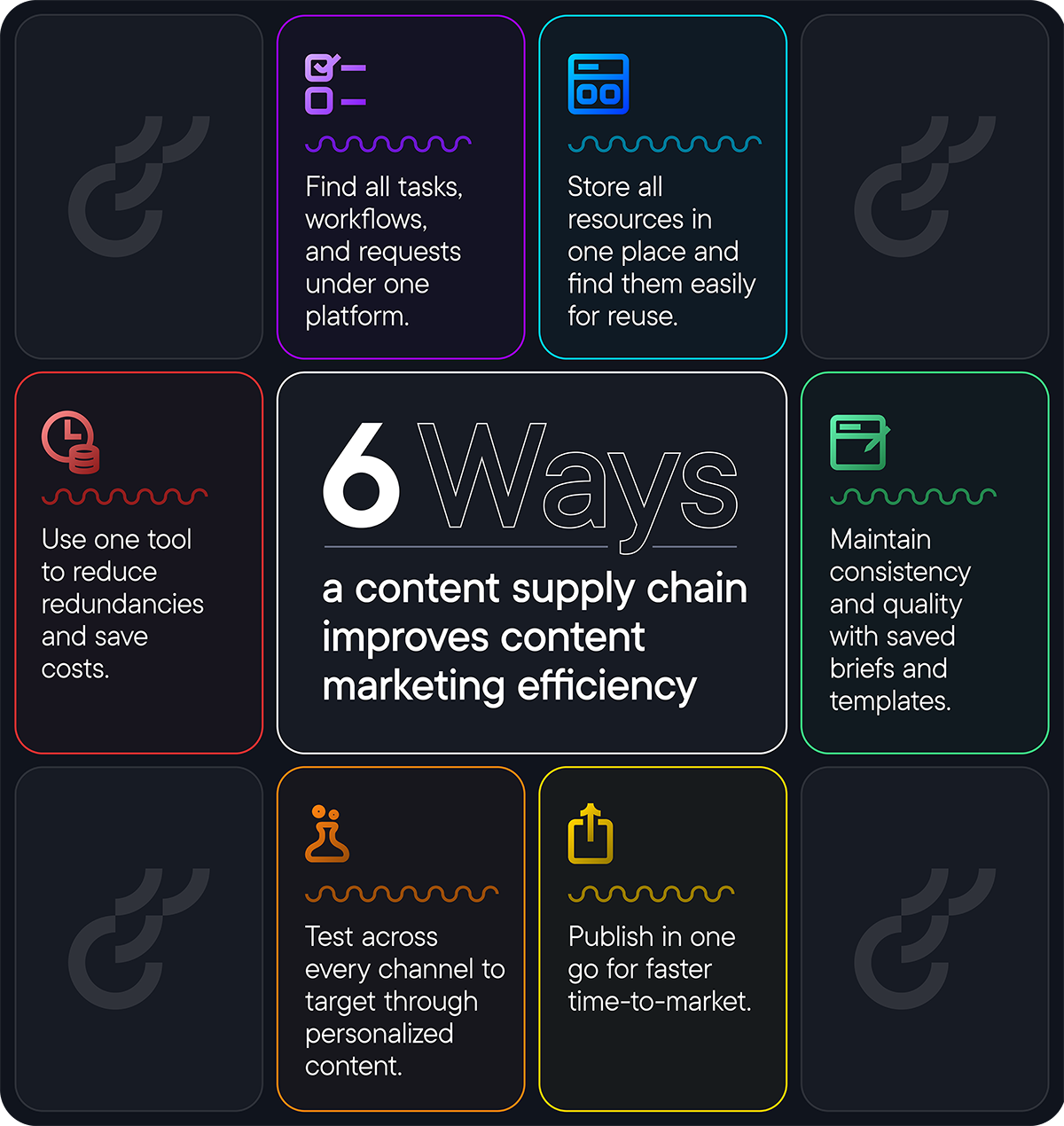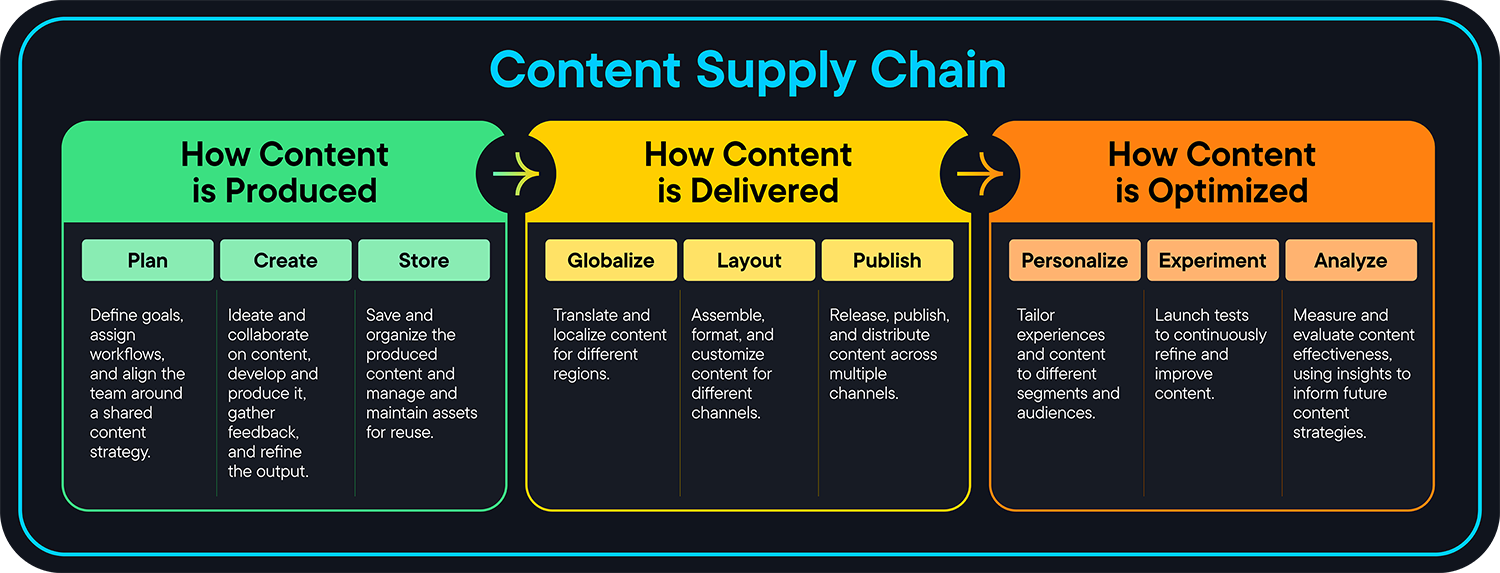Content supply chain
What is a content supply chain?
A content supply chain is a way of defining the process of planning, creating, managing, and distributing content across various channels under one platform.
However, most companies are struggling to effectively with their content lifecycle. With the rise of generative AI, velocity expectations and the need for governance are higher. We need to consider the bigger picture, processes, and change management.
Many marketing teams are struggling with siloed processes, and workflows that lack the transparency for the team members to work and collaborate in one single place.
When thinking of your content supply chain, focus on the following questions.
- What does your organization's content supply chain look like today?
- How many tools does your team use to support this end-to-end?
- Where are the bottlenecks and what’s stopping you from reaching your business goals?
- What level of visibility do you have as a leader in this supply chain?
- If you had a magic wand, how would you optimize this process to get campaigns out the door faster and get higher ROI?
How does a digital content supply chain improve content marketing efficiency?
A content supply chain streamlines the entire content creation and content marketing efficiency in many ways.

Image credit: Optimizely
Here are a few examples:
- Streamlined processes: Unified workflows that give everyone the transparency to do their best work, together.
- Resources you can find: Manage and assign tasks in one place. Plus, store and maintain assets for reuse.
- Consistency with quality: Maintain Standard Operating Procedures (SOPs) and briefs across all tasks, enhancing content quality and output.
- Faster time-to-market: Omnichannel delivery enables teams to publish content everywhere in one go.
- Data-driven insights: Powerful analytics and the ability to test across any channel will allow you to target with precise personalization.
- Lower costs: By using one tool to reduce redundancies and optimize resource allocation, you can lower production costs.
Overall, a well-managed content supply chain is an end-to-end process that enables total visibility, unrivaled speed, and clear insights, so you can achieve your content goals and deliver customer experiences that your target audience will love.
The 5 stages of a content supply chain
A high-quality content supply chain involves processes to create, manage, and distribute content effectively.
 Image credit: Optimizely
Image credit: Optimizely
Here’s how a content supply chain supports content production, delivery, and optimization:
-
Manage intake
- Raise work requests: Have standardized intake templates so everyone can submit requests in one place.
- Review content gap: Analyze existing gaps and assign each request using pre-defined logic.
- Submit idea: Allow teams to collectively triage and manage requests and decide which ideas are great.
-
Plan
- Allocate budget: Determine the financial resources needed and if external resources are required.
- Write brief: Draft content briefs to help folks collaboratively align on the key objectives, messaging, and ownership.
- Assign tasks and timelines: Delegate specific tasks and set deadlines. With a calendar view, everyone knows what's running when and in what region.
-
Create
- SEO/Content research
- Use generative AI: Jumpstart content ideation and creation (both images and text) to get the first draft of ideas.
- Develop draft: Finetune the AI draft by adding a human touch, humor, and regional/industry-specific examples.
- Digital asset management: Apply tags, store assets in one place, and make it easy to re-discover content assets in a library.
- Ask for review: Collaborate with peers, request feedback from relevant stakeholders, and make changes on the fly in one place.
-
Deliver
- CMS: Use a Content Management System to publish content, update page layout and add design elements.
- Mobile app: Distribute content via mobile applications.
- Marketing automation: Make edits directly on any page of your website and see updates in real-time.
- Social media: Publish on important channels like LinkedIn, Instagram, Twitter, etc., directly from your Content Marketing Platform.
- Ads: Promote content and run campaigns through paid advertising.
- Globalize: Localize content for different regions so it’s relatable for the audience.
-
Optimize
- Personalized experiences: Show personalized content to every visitor to meet their specific needs. Tailor it for various segments.
- Experiment: Test content strategies and formats across every channel.
- Analyze: Measure content performance through in-built analytics and make improvements accordingly.
Read more about what a fully functional content supply chain that’s focused on the creation process and creative processes looks like in 2024 here.
Content supply chain metrics
To effectively manage and improve your content supply chain, consider tracking these key metrics:
- Content velocity: Measure of how quickly content moves through the supply chain. At Optimizely, we run OOO campaigns in-house and it even got our CMO a text from his old school pal.
- Content utilization rate: Percentage of created content actually used in campaigns.
- Time-to-market: Duration from content ideation to publication.
- Content ROI: Measure of content performance against production costs. Check out this blog on getting content ideas out the door faster.
AI in content supply chains
Artificial Intelligence is revolutionizing content supply chains. Here are some key applications:
- AI-powered content ideation and topic clustering
- Automated content tagging and categorization
- AI-assisted content personalization at scale
- Predictive analytics for content performance
While all this may sound fancy talk, we've published an AI playbook for marketers. A step-by-step guide to publishing content using AI without losing the human touch.
Plus, you can maximize the value of content by repurposing what you publish. For example:
- Turn long-form content into social media snippets
- Turn written content into visual formats (infographics, videos)
- Localize content for different markets and cultures in multiple languages
Best practices for optimizing a content supply chain
Here are 8 best practices for creative teams looking to run content production and content supply chain smoothly:
- Define goals and align all your teams around a shared strategy.
- Use standardized forms for all intake requests.
- Clearly define roles, responsibilities, and timelines.
- Publish on relevant channels and regularly analyze content performance metrics.
- Translate and localize content for different platforms.
- Personalize your content. Tailor your digital experiences for different segments.
- Use a Content Marketing Platform (CMP) with inbuilt SEO research capabilities.
- Run tests regularly to understand what piece of content is performing well and what needs optimization for the right audience.
![]()

